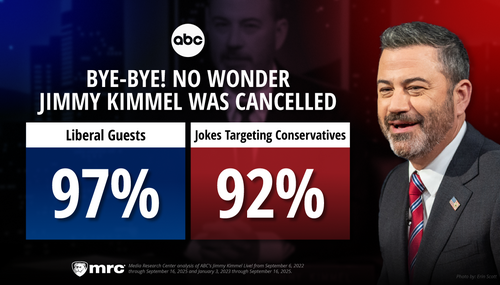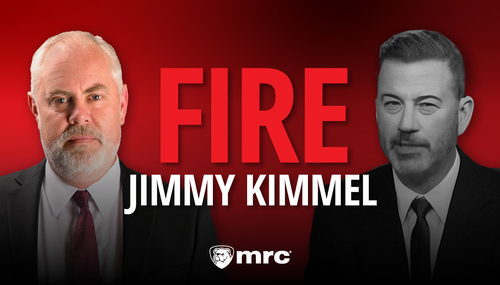It goes without saying that climate realists around the world believe Nobel Laureate Al Gore used false information throughout his schlockumentary "An Inconvenient Truth" in order to generate global warming hysteria.
On Friday, it was revealed by ABC News that one of the famous shots of supposed Antarctic ice shelves in the film was actually a computer-generated image from the 2004 science fiction blockbuster "The Day After Tomorrow." [audio available here]
Adding delicious insult to injury, this was presented by one of ABC's foremost global warming alarmists Sam Champion during Friday's "20/20":
SAM CHAMPION (ABC NEWS)
(Voiceover) Al Gore's 2006 documentary, 'An Inconvenient Truth," makes the same point with actual video of ice shelves calving. Which shots have more impact?
AL GORE (FORMER UNITED STATES VICE PRESIDENT)
And if you were flying over it in a helicopter, you'd see it's 700 feet tall. They are so majestic.
SAM CHAMPION (ABC NEWS)
(Voiceover) Wait a minute, that shot looks just like the one in the opening credits of "The Day After Tomorrow."
KAREN GOULEKAS (VISUAL EFFECTS SUPERVISOR)
Yeah, that's, that's our shot. That's a fully computer generated shot. There's nothing real in there.
SAM CHAMPION (ABC NEWS)
(Voiceover) Audiences expect Hollywood to twist fact into fiction. But Gore's documentary does the opposite, using a fake shot to make a real point, that ice shelves are disappearing, and vanishing ice means global warming.
Apparently, ABC tried to get a comment from Gore concerning the matter, but none was forthcoming:
SAM CHAMPION (ABC NEWS)Related Stories
- Gore admits financial 'stake' in advancing warming hysteria
- Enviro activist pressures BBC to significantly alter article
- Time magazine cover sparks outrage from Iwo Jima vets
- Time editor defends cover, denounces 'fantasy' of objectivity
- Gore bars press from speech in San Francisco
- World's oldest tree rewrites climate history, challenges global warming
- Gore's alarmism failing: Concern for global warming same as 19 years ago
(Off-camera) And it raises another question for you to consider. Is it wrong for a documentary to use a fabricated Hollywood shot to make a point, even if there's science behind it? Well, we tried to ask Al Gore and the movie studio, but neither responded to our calls.
I wonder why.
Yet, another mystery here is that ABC posted a video of this segment at its website. However, for some reason, the clip ends BEFORE the discussion of Gore's film.
I wonder why.
What follows is a full transcript of this segment.
SAM CHAMPION (ABC NEWS)
(Off-camera) It seems like there's nothing like a natural disaster to get Hollywood's imagination going. But do movies like the 'Poseidon Adventure" reflect real life or distort it?
GRAPHICS: "CATEGORY 6"
SAM CHAMPION (ABC NEWS)
(Voiceover) Nothing matches Mother Nature gone wild in those weather disaster movies. The special effects can blow an audience right out of their seats, and you'll definitely think twice about going on a cruise after seeing 'Poseidon..."
GRAPHICS: "POSEIDON"
SAM CHAMPION (ABC NEWS)
(Voiceover) ...An enormous ocean wave bigger than anything ever recorded capsizes a cruise ship, and only a few passengers survive.
CLIP FROM "WATERWORLD"
SAM CHAMPION (ABC NEWS)
(Voiceover) In another maritime movie, global warming causes water to cover the Earth. The science is so shaky in 'Waterworld" that Kevin Costner even grows webbed feet, and take a look behind his ears.
ACTOR (MALE)
Gills.
CLIP FROM VARIOUS MOVIES
SAM CHAMPION (ABC NEWS)
(Voiceover) Is good science a myth in these movies? It's hard to tell when convincing visuals give light to fictitious weather catastrophes, from inland hurricanes to an imaginary icing.
DAVID KIRBY (AUTHOR)
I mean, cinema makes good science and bad science equally realistic.
SAM CHAMPION (ABC NEWS)
(Voiceover) Author David Kirby attended a recent National Science Foundation meeting of scientists and entertainment producers.
DAVID KIRBY (AUTHOR)
You should worry about the small details.
SAM CHAMPION (ABC NEWS)
(Voiceover) Their topic, legitimate science in TV and film. Kirby says audiences can be naive, some worrying about lava in there own backyards, for example, after seeing 'Volcano."
CLIP FROM "VOLCANO"
SAM CHAMPION (ABC NEWS)
(Voiceover) In that movie, Tommy Lee Jones has good instincts when he first discovers a problem beneath Los Angeles.
TOMMY LEE JONES (ACTOR)
Find me a scientist, somebody tell me what the hell is going on.
JAKE LOWENSTERN (GEOLOGIST
You have to have the right scientist.
SAM CHAMPION (ABC NEWS)
(Voiceover) That would be Jake Lowenstern, the geologist in charge of the Yellowstone Volcano Observatory. So how realistic is a lava flow down Wilshire Boulevard?
JAKE LOWENSTERN (GEOLOGIST
Los Angeles is not one of the more likely places to have a volcanic eruption anytime soon. That one was a little bit outrageous.
CLIP FROM "DANTE'S PEAK"
SAM CHAMPION (ABC NEWS)
(Voiceover) Lowenstern says movies need a scientific base, case in point, another volcano movie, 'Dante's Peak."
PIERCE BROSNAN (ACTOR)
This mountain's a ticking bomb.
SAM CHAMPION (ABC NEWS)
(Voiceover) Pierce Brosnan, the scientist, predicts the eruption. It's an explosion of ash and gases of obliterating buildings, toppling trees, and spreading destruction for miles.
KEVIN FURLONG (PENNSYLVANIA STATE UNIVERSITY)
That's one of the scenes that probably is the most scientifically accurate. We know from when Mountain Saint Helens erupted, it blow outwards and it, it laid all the trees down in one direction.
SAM CHAMPION (ABC NEWS)
(Voiceover) Kevin Furlong and Chuck Ammon used clips from a dozen movies to supplement a course at Penn State University on natural disasters.
DOCTOR CHUCK AMMON (PENNSYLVANIA STATE UNIVERSITY)
Every clip is another exercise in critical thinking. Was that real? It was not fake. Is that realistic or is that completely unrealistic?
SAM CHAMPION (ABC NEWS)
(Voiceover) The professors find the worse the movie, the better the teaching tool. One of their favorites, 'Twister."
CLIP FROM "TWISTER"
HELEN HUNT (ACTRESS)
Cow.
SAM CHAMPION (ABC NEWS)
(Off-camera) Cows are flying through the air. You can hear them moo.
DOCTOR CHUCK AMMON (PENNSYLVANIA STATE UNIVERSITY)
It's like the 'Wizard of Oz."
SAM CHAMPION (ABC NEWS)
(Off-camera) I mean, am I right? When these thing's gonna go by you so quickly, you don't even know it's a cow.
KEVIN FURLONG (PENNSYLVANIA STATE UNIVERSITY)
Oh, sure, because you know that it's going at, what, 200 miles per hour or faster?
DOCTOR CHUCK AMMON (PENNSYLVANIA STATE UNIVERSITY)
It's moving at bullet speeds.
SAM CHAMPION (ABC NEWS)
(Off-camera) Some people got very angry about this in the weather profession because it makes it look like you don't need to get out of the way of a tornado.
KEVIN FURLONG (PENNSYLVANIA STATE UNIVERSITY)
Well, I think there's always that risk with any of these natural disaster movies that you are making it appear that people can survive them.
DOCTOR CHUCK AMMON (PENNSYLVANIA STATE UNIVERSITY)
Here's a, a shot of Hurricane Katrina. There's the eye of the storm.
SAM CHAMPION (ABC NEWS)
(Voiceover) The class arms these students with the knowledge of real weather catastrophes.
DOCTOR CHUCK AMMON (PENNSYLVANIA STATE UNIVERSITY)
Katrina's storm surges were on the order of 15 feet and - in a couple of places up to 30 feet.
CLIP FROM "THE DAY AFTER TOMORROW"
SAM CHAMPION (ABC NEWS)
(Voiceover) But the storm surge in "The Day After Tomorrow" nearly covers the Statue of Liberty, a whopping 300 feet. That's 10 times the size of Hurricane Katrina's storm surge.
DENNIS QUAID (ACTOR)
I think we're on the verge of a major climate shift.
SAM CHAMPION (ABC NEWS)
(Voiceover) In this 2004 blockbuster, global warming triggers a change in ocean patterns, setting off hailstorms in Tokyo, tornadoes in Los Angeles...
ACTOR (MALE)
This tornado just came and erased the Hollywood sign.
SAM CHAMPION (ABC NEWS)
(Voiceover) ...and the enormous tidal surge engulfs Manhattan. The movie's visual effects supervisor was Karen Goulekas.
KAREN GOULEKAS (VISUAL EFFECTS SUPERVISOR
You started all of these and you say, okay, it's a 30-foot storm tide, a wall of water. But then you look in the shot and in some shots, 30 feet looks too wimpy. And so you just scale it up. What are you gonna do, show the water going up to the ankles of the Statue of Liberty? I mean, you know, it's obviously, if the Statue of Liberty's getting covered over, it's like, uh-oh, we're in big trouble.
JAKE GYLLENHAAL (ACTOR)
Let's go.
SAM CHAMPION (ABC NEWS)
(Voiceover) The biggest trouble, an ice age that flash freezes most of the world. These clearly made up weather events in "The Day After Tomorrow" still resonated with the audience. In one study, a Yale professor found that after watching the movie, viewers were encouraged 'to engage in personal, political and social action to address climate change."
GRAPHICS: EXCERPT FROM ENVIRONMENT ARTICLE
SAM CHAMPION (ABC NEWS)
(Voiceover) "The Day After Tomorrow" dramatizes global warming with scenes like this.
ACTOR (MALE)
The whole damn shelf is breaking off.
AL GORE (FORMER UNITED STATES VICE PRESIDENT)
These glaciers are so beautiful.
CLIP FROM "AN INCONVENIENT TRUTH"
SAM CHAMPION (ABC NEWS)
(Voiceover) Al Gore's 2006 documentary, 'An Inconvenient Truth," makes the same point with actual video of ice shelves calving. Which shots have more impact?
AL GORE (FORMER UNITED STATES VICE PRESIDENT)
And if you were flying over it in a helicopter, you'd see it's 700 feet tall. They are so majestic.
SAM CHAMPION (ABC NEWS)
(Voiceover) Wait a minute, that shot looks just like the one in the opening credits of 'The Day After Tomorrow."
KAREN GOULEKAS (VISUAL EFFECTS SUPERVISOR
Yeah, that's, that's our shot. That's a fully computer generated shot. There's nothing real in there.
SAM CHAMPION (ABC NEWS)
(Voiceover) Audiences expect Hollywood to twist fact into fiction. But Gore's documentary does the opposite, using a fake shot to make a real point, that ice shelves are disappearing, and vanishing ice means global warming.
KAREN GOULEKAS (VISUAL EFFECTS SUPERVISOR)
That was one hell of a shot. I think it's great that he used it.
SAM CHAMPION (ABC NEWS)
(Voiceover) It seems the decision for now is left to the audience. Can the same created image educate and entertain us about our planet in change?
SAM CHAMPION (ABC NEWS)
(Off-camera) And it raises another question for you to consider. Is it wrong for a documentary to use a fabricated Hollywood shot to make a point, even if there's science behind it? Well, we tried to ask Al Gore and the movie studio, but neither responded to our calls. John Stossel will back right after this.
COMMERCIAL BREAK
JOHN STOSSEL (ABC NEWS)
And that's our program for tonight. Our thanks to Sam Champion for clearing up those myths about weather. And if you have myths you'd like to share about weather or anything, log on to my webpage at ABCNEWS.com. If you give us some original and surprising ones, we'll put them on '20/20" and in our next myth book. I'm John Stossel. For Elizabeth Vargas and all of us at ABC News and '20/20," we're in touch, so you be in touch.




